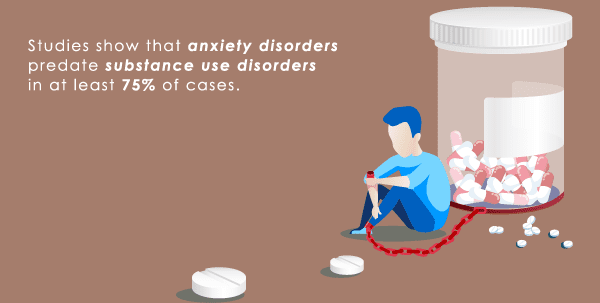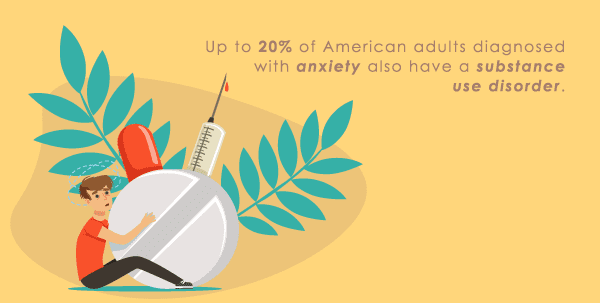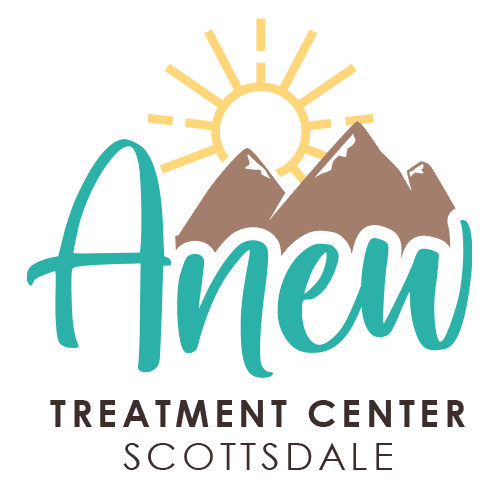The Connection Between Anxiety and Addiction
Learn more about the connection between anxiety and addiction and where to find treatment here.

Understanding Anxiety and Addiction
Experiencing anxiety, whether chronic or acute, can lead someone to seek out ways to manage their symptoms. To alleviate the emotional and physical pain associated with anxiety, individuals often turn to drugs or alcohol to find relief, calm, and relaxation. Sadly, the perceived benefit of using drugs or drinking alcohol to manage anxiety typically leads to harmful, long-term effects, including developing co-occurring anxiety and addiction disorders.
Also called a dual diagnosis, a co-occurring disorder means having two disorders simultaneously. Regardless, because the symptoms overlap, it can be challenging to find relief and healing from either condition without help from a treatment program specializing in dual diagnosis treatment.

What Is Anxiety?
Anxiety is a normal human emotion we all feel from time to time; however, the fear and apprehension accompanying an anxiety disorder are more than passing worry or concern. Anxiety disorders involve an ongoing and persistent struggle that interferes with day-to-day life. Note that it is common for anxiety symptoms to begin during childhood and continue throughout one’s lifetime. In addition, there are several types of anxiety disorders, and it is possible to experience symptoms from one or multiple anxiety disorders.
Generalized Anxiety Disorders (GAD)
The Relationship Between Anxiety and Addiction
The relationship between anxiety and addiction is well-known but difficult to define clearly. No research studies exist to date that shows whether one illness causes the other; however, their symptoms are heavily intertwined and often share similar root sources.
Addiction and anxiety disorders frequently co-occur, meaning people experience symptoms from both conditions at the same time. Research from the Anxiety and Depression Association of America suggests that 20% of people diagnosed with an anxiety disorder also have a substance use disorder (SUD) or anxiety and addiction co-occurring disorder.1
Types of Anxiety Disorders
According to the NAMI, the National Alliance on Mental Illness, anxiety disorders are the most commonly diagnosed illness in the US. Research suggests that as many as forty million adults struggle with anxiety. Anxiety disorders are treatable, yet few ever seek or receive the help they need. Research from the Anxiety and Depression Association of America (AADA) estimates less than 37% of people with anxiety disorder get treatment.2
The fifth edition of the Diagnostic and Statistical Manual for Mental Disorders (DSM-5) provides diagnostic criteria used by treatment professionals to diagnose anxiety disorders. While there are several possible diagnoses, some are statistically more common than others overall and often co-occur with addiction at a higher rate.

Anxiety and Addiction
Generalized Anxiety Disorder (GAD)
Generalized anxiety disorder (GAD) is characterized by chronic or ongoing anxiety. Someone with GAD will experience elevated tension or heightened worry regardless of whether there is a reason to feel concerned.
Post-Traumatic Stress Disorder (PTSD)
Post-traumatic stress disorder (PTSD) occurs after a traumatic experience that causes harm or the threat of harm. Common examples of trauma often linked to PTSD include accidents, violence, assault, and natural disasters.
Social Phobias (Social Anxiety Disorder or Social Anxiety)
Social phobias or social anxiety disorders are characterized by uncontrollable feelings of stress and self-consciousness during everyday social situations.
Obsessive-Compulsive Disorder (OCD)
People with obsessive-compulsive disorder (OCD) struggle with recurrent and unwanted thoughts (obsessions) and repetitive behaviors (compulsions). Compulsions, also called rituals, are performed to reduce the intensity of obsessions. Often, compulsions are ineffective or provide only temporary relief; however, failure to perform them leads to excessive and uncontrollable anxiety.
Panic Disorders
Those with a panic disorder experience repeated and often unpredictable or unexpected episodes of overpowering fear. This fear is also accompanied by various physical challenges, including racing heart, difficulty breathing, stomach problems, etc.
A Deeper Look at Panic Disorders
Phobias (Specific Phobias)
Specific phobias are intense fears of particular objects or situations, such as spiders, water, or flying on an airplane. This fear goes beyond what a person would usually feel when exposed to this level of stimuli. As a result, phobias may cause someone to avoid certain situations or environments where they could come face-to-face with their fear. Depending on the individual's symptoms, a social phobia can be limited to a specific situation or involve all social circumstances.
Acute Stress Disorder (ASD)
Acute stress disorder (ASD) is a set of intense and unpleasant symptoms that arise in the days or weeks immediately following a traumatic event. Often, symptoms last for up to one month before resolving without significant intervention. If symptoms of ASD persist beyond one month, evaluation for post-traumatic stress disorder (PTSD) is necessary.
What Causes Anxiety Disorders?
Research has not provided a singular cause or risk factor that increases one’s risk of developing an anxiety disorder despite several studies on anxiety. Instead, data collected during these studies suggests it is likely a combination of several contributing factors, including trauma history, family history, stress, underlying mental health conditions, and co-occurring addiction and anxiety.

Anxiety and Addiction
Family History and Genetic Influences
Family history and genetic influences can contribute to the risk of developing an anxiety disorder. A study from 2019 suggests if a direct family member has an anxiety disorder, other immediate family members are at a greater risk of developing anxiety.3
Unresolved or Excessive Stressors
In addition to genetics, unresolved or excessive stressors can elevate one's risk of experiencing acute or chronic anxiety conditions. Chronic or unresolved stress can significantly impact specific brain areas responsible for helping people manage stress reactions. When these areas are overstimulated, handling stressors safely and healthily can be challenging. For some, this can also lead to struggles with co-occurring disorders like anxiety and addiction due to using drugs or alcohol or self-medicating.
Trauma
Experiencing trauma, whether recent or in the past, can increase the risk of developing anxiety. It is not uncommon to experience anxiety after witnessing a frightening incident or learning about a traumatic experience of a loved one. Traumatic life events, such as divorce, loss of a loved one, severe illness or injury, or other significant life changes, can also lead to anxiety.
Dual Diagnosis
Dual diagnosis conditions occur when someone simultaneously struggles with a mental health condition and substance use disorder. While co-occurring anxiety and addiction are common, dual diagnosis conditions can be any combination of mental health diagnoses and SUD. Unfortunately, many people who struggle with severe or recurring mental health symptoms turn to drugs or alcohol to reduce the impact of their symptoms. This practice can lead to dependency and addiction to the effects of substances to manage ongoing, untreated symptoms.
Existing Substance Abuse
Finally, existing substance addiction can also lead to new or worsening mental health struggles and, inevitably, a dual diagnosis. Several mental health symptoms can evolve out of addictive behaviors. For example, while actively consuming or trying to quit a substance, symptoms like depression, anxiety, irritability, and paranoia can occur.
The Most Common Addictive Substances Related to Anxiety Disorders

Anxiety and Addiction
Anxiety and substance use disorders are some of the most prevalent psychiatric problems in the United States, with lifetime rates of 28.8% and 14.6%, respectively. When someone struggles with ongoing, persistent feelings of anxiety, it is natural to seek ways to reduce the intensity of the symptoms.4
Often, people turn to drugs or alcohol to dull the emotional and physical pain that typically accompanies anxiety. This can lead to further complications, including anxiety and drug addiction or anxiety and alcohol addiction. These dual diagnosis conditions require comprehensive treatment in a dual diagnosis treatment center where professional, highly skilled staff understand the unique nature of helping people manage their symptoms safely and effectively.
Prescription Medications
There are several prescription and non-prescription substances that people who struggle with anxiety disorders may use to reduce their symptoms. For some, prescription medications like benzodiazepines and certain stimulant drugs are used as part of a therapeutic program. Although beneficial in many ways, benzodiazepines are highly addictive, and even short-term prescription use can lead to challenges with dependency and addiction.
Illicit Substances
When prescription medications are no longer available (or never prescribed), it is not uncommon for someone experiencing debilitating anxiety to use illicit substances like cocaine and methamphetamine or substances like alcohol and marijuana to manage their symptoms. Whether legal or illegal, using substances to self-medicate symptoms often worsens mental and physical health challenges.
Common Risk Factors of Anxiety and Addiction Dual Diagnosis
Several factors may increase one's risk of developing co-occurring anxiety and addiction.
Self-Medicating
The first is using substances to self-medicate. Self-medication is consuming drugs or alcohol to dull painful physical or emotional symptoms connected to mental or even physical health conditions. In the case of co-occurring anxiety, drugs or alcohol are used to reduce pain, fear, stress, or inhibitions, allowing someone struggling with crippling anxiety symptoms to function "normally."
Unfortunately, using substances in this way generally leads to a problematic relationship with drugs or alcohol. In time, the body and brain become dependent on the impact of substances, and the ability to perform daily tasks without using or drinking first becomes more and more complex. Thus, ongoing self-medication can cause addiction.
Withdrawal
Addiction and anxiety dual diagnosis can also occur due to the effects of substance addiction or withdrawal. One of the most common impacts of withdrawing or detoxing from drugs or alcohol is experiencing powerful mental health symptoms. In some cases, when one chooses to detox cold turkey or without the help of a professional treatment program, these symptoms can become so powerful that it quickly leads to a relapse in substance use. The anxiety that arises from not drinking or ingesting a substance can be overwhelming, creating the impulse to continue alcohol or drug use as a coping mechanism.
Biochemical Factors and Genetic Predisposition
In addition to dual diagnosis that evolves out of self-medication or withdrawal, biochemical factors and genetic predisposition may also increase one's risk for developing a dual diagnosis condition. Biochemical factors are biological processes that occur within your body. As with genetic predisposition, biochemical factors that contribute to anxiety, addiction, or other dual diagnosis conditions are unique to the individual and often unpredictable.
Anxiety and Addiction Treatment Options

Anxiety and Addiction
When people experience symptoms of a mental health condition like anxiety and addiction, it is called a dual diagnosis or co-occurring disorder. Dual diagnosis conditions are more common than many people realize. Data provided by the Substance Abuse and Mental Health Services Association (SAMHSA) indicated nearly 50% of those who sought help at a mental health treatment program also had a co-occurring substance use disorder.5
As mentioned above, dual diagnosis conditions like addiction and anxiety disorders share many overlapping symptoms; therefore, the best opportunity for recovery is to choose a treatment program where dual diagnosis treatment is available.
Detoxification
The first step for many who seek help to overcome an anxiety and addiction co-occurring disorder is detox. Many commonly abused substances are difficult to merely stop using without help and support. In some cases, such as alcohol addictions or addictions to opioids and benzodiazepine, quitting cold turkey can have dangerous and potentially life-threatening consequences.
Therefore, detoxing at a treatment center specializing in anxiety and addiction co-occurring disorder treatment ensures patients have the medical and emotional support and guidance to safely manage the early stages of detox with withdrawal symptoms—which can be the most challenging.
Therapy
After completing detox, the next stage of anxiety and addiction treatment is therapy. Dual diagnosis programs are designed to help patients learn more about the relationship between anxiety and addiction. By learning more about how mental health challenges, such as anxiety, can lead to new or worsening struggles with substance abuse. The treatment professionals at a dual diagnosis treatment center work with each patient to develop a therapeutic program designed around their treatment needs and goals.
Personalized Treatment Plan
The therapeutic model, duration of treatment, and other factors unique to anxiety and addiction treatment will vary from person to person. This variation is crucial as co-occurring disorders are illnesses that affect each person differently. Therefore, the path to overcoming symptoms and achieving lasting sobriety must be individualized and focused on each person’s needs, not their diagnosis.
Therapeutic Models
Most dual diagnosis treatment programs utilize various therapeutic models, including cognitive behavioral therapy (CBT), dialectical behavior therapy (DBT), and alternative options. In addition to evidence-based treatments, peer support groups, nutritional therapies, medication-assisted treatment, and other therapeutic methods are used as part of a comprehensive treatment program focused on helping people heal.
Aftercare
As the primary treatment program ends, patients will work with their treatment team to develop an aftercare plan. These continuing care plans include ongoing support and guidance to help with relapse prevention and comfort as patients transition back to their day-to-day routine.
Helping a Loved One With Anxiety and Addiction
If a loved one struggles with anxiety and addiction, it is natural to want to help but not know how or where to begin. It can be challenging, frustrating, and heartbreaking to watch someone you love struggle to manage difficult anxiety symptoms without success. Similar emotions can arise if your loved one turns to substances like drugs or alcohol to help dull the impacts of anxiety on their lives. It is important to remember that the decision to seek help must be their own, but there are things you can do to provide help and support.
Be Kind and Do Not Judge
First, it is essential to be kind, understanding, and nonjudgmental. Unfortunately, stigma, fear, and worry still surround mental health and addiction treatment conversations. Because of this, many who could benefit from help at an anxiety and addiction treatment program expect rejection, accusations, or harsh treatment from their loved ones.
Show Support
It is important to show that you still care for and love the person and you are here to help them on their journey to recovery. Instead of ultimatums or accusations, offer specific solutions and emotional support. Let them know you are here and available to talk, drive to appointments, help with research, or anything else they need to overcome anxiety and addiction.
Ask for Help
Do not be afraid to ask for help for your loved one and yourself. If you are unsure where to begin, contact a member of our team at Anew Treatment Center to learn more about family support and dual diagnosis treatment and the relationship between anxiety and addiction.
Do’s and Don’ts
Treatment for Anxiety and Addiction at Anew Treatment Center

Anxiety and Addiction
Overcoming the physical and emotional challenges connected to a dual diagnosis like addiction and anxiety requires comprehensive, evidence-based, and integrated treatment at a treatment facility like Anew Treatment Center. Our medical providers are skilled in dual diagnosis treatment and have the experience and knowledge needed to safely and effectively help each patient recover.
In the past, medical and mental health providers focused on treating addiction and mental health symptoms through separate programs. Unfortunately, this led to ineffective treatment outcomes for many as the symptoms and root causes of most dual diagnosis conditions are highly intertwined.
Dual Diagnosis Treatment Programs
Fortunately, dual diagnosis treatment programs understand both conditions must be addressed as part of one integrated treatment approach. At our dual diagnosis treatment program, we will work with you to understand your specific treatment needs and goals as you begin the journey to recovery. Through careful assessment and treatment planning, we will help develop a treatment program based on evidence-based treatment models designed to help you learn about the relationship between addiction and anxiety.
Contact Us Today
Overcoming a dual diagnosis without support and guidance can feel challenging and, in some cases, impossible. Seeking help from our caring and compassionate staff at Anew Treatment Center is the safest and most effective way to achieve lasting health, wellness, and freedom from anxiety and addiction. Contact us today to learn more about our programs and how dual diagnosis treatment can help.
Resources
- https://adaa.org/understanding-anxiety/co-occurring-disorders/substance-abuse
- https://www.nami.org/About-Mental-Illness/Mental-Health-Conditions/Anxiety-Disorders
- https://jamanetwork.com/journals/jamapsychiatry/fullarticle/2733149
- https://www.ncbi.nlm.nih.gov/pmc/articles/PMC2904966/
- https://www.samhsa.gov/data/sites/default/files/reports/rpt29394/NSDUHDetailedTabs2019/NSDUHDetTabsSect5pe2019.htm
Learn More About Our Treatment Programs
Our team is ready to talk and determine how we can help. Rest assured your call is confidential. We're here for you.


